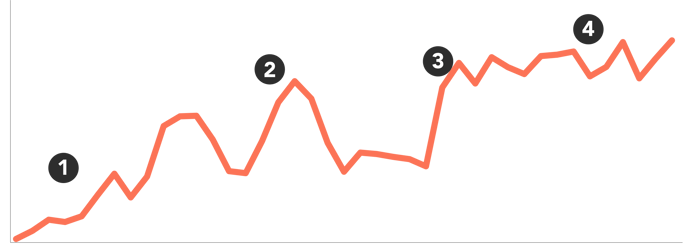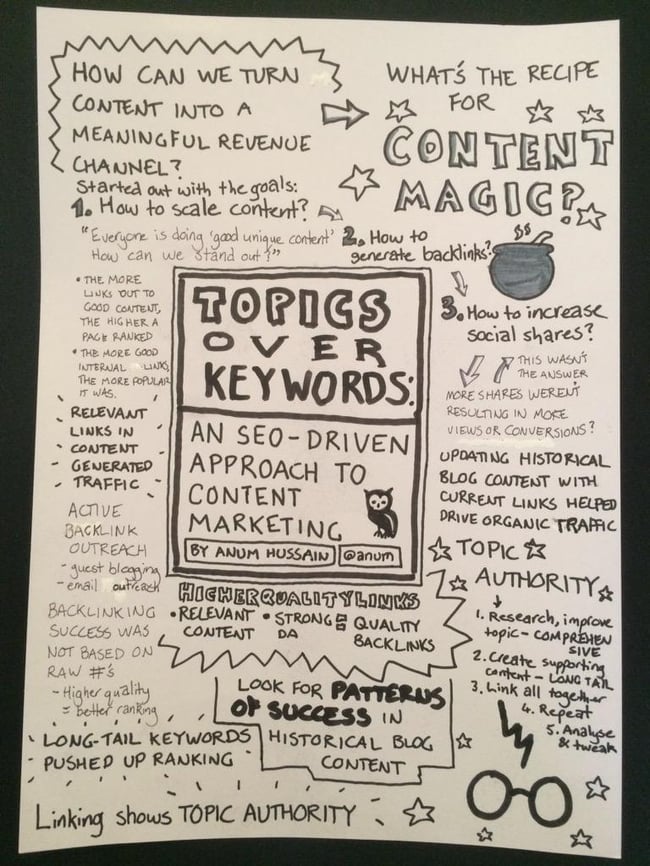Topics Over Keywords: An SEO-Driven Approach To Content Marketing
- 17 mins
Building a new content strategy from the ground up is damn hard.
Earlier this year, I released “Building a B2C2B Content Strategy.” Much of that presentation highlighted the experiments and struggles I faced building a content strategy for a new model.
While the experimentation cycle had many failures, there were enough successes for my crazy leaders to grant me a full team to double down on our efforts and enter the next stage of performance.
I was now tasked with going from a one-woman-creator to managing a team, from publishing a few blog posts to strategizing full content campaigns. In fact, by June 2015, we had four incredible growth marketers on my team and ready to take over the internet. As a group we set on a series of of mini-missions:
1. Scale production of our SEO site pages to fuel organic traffic.
2. Generate a mass of backlinks to help those site pages rank.
3. Increase the social share rate of our blog content.
Little did we know, we weren’t just embarking on a content journey - we were embarking on a completely SEO-driven one. This presentation walks through our three months of experiments, learnings, analysis, and the resulting SEO content strategy that can be summed into “topics over keywords.” If you’re interested in hearing how we grew ...
- Our domain authority from 40 to 60
- Our weekly organic sessions 13% W/W
- Our clicks from SERP for one keyword over 1,500%
… then clickthrough the slides below or dive into the written version of the deck below. A special shout out to Cambria Davies for all her analysis used throughout this piece, and the rest of the content squad - David Khim, Scott Tousley, and Mike Renahan - for all their work building our strategy together and making it insanely fun every step of the way.
As aforementioned, we set on three mini-missions. Let’s review each one (and some related definitions) first.
Mini-Mission 1: Scale production of our SEO site pages to fuel organic traffic.
In 2014, when I was still a team-of-one, I grew fascinated with HelpScout’s resources. I touched on this obsession in the third principle of my previous presentation, but will give it it’s deserved attention once more here.
You see, HelpScout creates a series of ungated (meaning the content is not gated with a form) resources. Similar to ebooks, they are comprehensive guides on a specific subject. Some refer to them as “HTML ebooks.”
But unlike ebooks, they’re not hidden behind a lead generation form; instead they’re available for anyone to view. This allows the page to rank in search (since Google can actually read it’s full content) and optimized for new contacts through calls-to-action on the page.
In fact, HelpScout’s resource on “user acquisition” ranks number one in SERP for that search - even above Wikipedia, which if you’ve ever dabbled in the world of SEO, know how impossible that is. In 2014, I experimented with building out a page for the topic of “email tracking.”
Within a few months, the page was ranking and generating hundreds of new users. So when we built out our feel content team, we developed a playbook for building what we call an "SEO Site Page" and put the incredibly intelligent Cambria Davies in charge of scaling production. While I won’t disclose the full playbook, let’s quickly review how we define an SEO Site Page.
SEO Site Page:
a piece of web content developed as a comprehensive guide on a specific keyword with the goal of ranking among the top 5 SERP results for said keyword.
The core ingredients of our full playbook include:
- Researching a spectrum of keywords to target, grouping all similar and semantic terms.
- Assessing keyword opportunities for intent through the See-Think-Do framework.
- Analyzing top 10 SERP results to assess likelihood of creating a “10x” content piece that can outrank current results.
After a few iterations, we launched 8 SEO Site Pages. Here’s a few (click the icons to view):
After launching 10 Site Pages, five began ranking in top 10 SERP placements. When we began questioning why half the pages ranked and half didn’t, we saw a variety of factors. Two of the major ones revolved around how we integrated links.
Learning 1: More outbound external links = higher placement in SERP.
We found that the more links we included on a page pointing to related, external content, the higher we ranked.

For example, let’s say we created, “The Ultimate Guide to Picking a Hogwarts House.” In this guide, we comprehensively cover everything one would need to research to understand which house would be best for them. In the second chapter of the guide, we discuss the meaning behind each house’s colors. And while we cover it well, perhaps there’s a whole psychological element to colors that we didn’t want to go into detail of, but there’s another great resource covering it.
By linking to that other, relevant piece of content from another company or media site that helps enhance the entire UX of our Site Page, we were showing Google that this one resource was everything one needed to match their query - whether the answer was on that exact page or through a link to another resource.
Learning 2: More internal links = higher placement in SERP.
Similar to linking to other sites, we also saw great results from weaving our own content together more tightly.

For example, let’s look at that Hogwarts House guide again. Let’s say we previously wrote a blog article on being “The Slytherin’s Guide To “Parseltongue" and another post on the “10 Habits of Highly Productive Hogwarts Founders.” By linking our complete Site Page to these relevant blog posts, we saw a similar result as the previous learnings: ranking higher in SERP.
Mini-Mission 2: Generate a mass of backlinks to help those site pages rank.
While we can own the quality of our content - meaning we have control over how comprehensive it is, how well-designed it is, what the URL structure is, and so on - we can’t control the external factors that Google favors so dearly. One of the primary external factors is backlinks.
Backlinks:
another way of saying inbound link; an incoming link from another website pointing to content on your domain
We can’t guarantee that other websites with high DAs (meaning Google trusts them) will find and link back to our content, subsequently helping that content rise in SERP. We put two hustlers - David Khim and Mike Renahan - up to the task of developing our promotion playbook for backlinks. The two of them ended up formulating a process that has helped our top SEO Site Pages get even more exposure though two avenues:
- Guest blogging to earn a backlink within the contributed post
- Email outreach to earn a backlink through email requests
We measured this mission by setting goals around raw number of links. We were aiming for quantity - simply generate as many inbound links as we could. But after going through a few iterations, we went back and learned something very interesting …
Learning 3: Backlink quality > backlink quantity.
As you can see in the table below, the Email Etiquette guide was ranking higher (now at spot 6) despite a fewer number of total backlinks.

We analyzed every backlink we generated and realized that there was a success formulae behind backlinks to follow:
Let’s breakdown the formula.
Relevant Content: The external web page linking to our site page is on a similar topic. For example on the Networking Email Site Page that isn’t ranking as well, we earned a strong number of backlinks. But some of them weren’t on relevant subjects.
For example, we wrote blog post on the “X Habits of Social Media Marketers” for a social media blog where one of the habits was around networking, giving us the opportunity to link to our Site Page. But simply earning the link wasn’t enough. Looking at the grander context of the page, it was not about networking. Meanwhile when we wrote guest blog posts linking to the Email Etiquette guide, we wrote posts about email etiquette, email acronyms, and other very similar subjects.
Strong DA: This component is far simpler. We essentially needed to ensure the URL we were earning links from had a domain authority of 40 or above. Anything below that just wasn’t a “legit” enough site from Google’s algorithm perspective.
Mini-Mission 3: Increase the social share rate of our blog content.
Our final mission was centered around boosting traffic to our weekly blog content (not SEO site pages) to continue growing our traffic there by reaching new audience through current readers. The idea was inspired and led by Scott Tousley, one of the most passionate and experimental content marketers I’ve ever met.
This concept is very tangible: The more our content is shared —> the more exposure we get —> ideally leading to clicks back to our original post to influence more regular readers. Since our blog was our home base for keeping our readers engaged, we wanted to grow our audience there to ultimately help our Site Pages as well.
Unfortunately, this didn’t play out as desired.
Learning 4: More social shares ≠ more views.
We essentially found that more social shares was not resulting in more views of our content.

Even if there was a blog post with 8x more shares than another, the total views was hardly impacted, if impacted at all.
Learning 5: More social shares ≠ more conversions.
We decided to question this further against conversions, just to ensure there wasn’t some other value social shares were deriving. But even in that case, there was no real correlation.

After interviewing our audience, we also uncovered that our target readers weren’t big social sharers. And of those who did share, most didn’t have a large enough following to influence more views or conversions.
So at this point, we worked on our three mini-missions and we uncovered some key learnings. And by the end of missions, our metrics had grown in a few stellar ways.
We specifically grew:
- Our domain authority from 40 to 60
- Our weekly organic sessions 13% W/W
- Our clicks from SERP for one keyword over 1,500%
Most people look at these up-and-the-right metrics and think, great! Keep doing what you’re doing.
But principle three of our content strategy is: Allow data to inform intelligent decisions. So far us, it’s not enough to analyze progress when we fail, but when we succeed. Often our success is far more insightful in helping us develop our strategy moving forward.
So we kept digging, kept questioning, and uncovered some more learnings.
Learning 6: Updating historical blog content with related Site Page links helped increase organic traffic for the old blog post as well as the new site page.
Let's review an example post in this bucket to explain the impact we discovered. One of our well-performing posts followed this organic traffic growth pattern:

1. We launched this post in late 2014 and naturally saw some slight organic traffic kick in.
2. In early 2015, the post saw a few spikes in traffic but always dipped back down again.
3. In the summer of 2015, we republished the post with optimized links to a new, related site page (also referred to as "optimizing the past"), and saw organic traffic spike again.
4. After the re-publish with added site page relevancy, organic traffic didn't dip again but instead now continues to grow at a new bar of weekly search traffic to the post.
Learning 7: Long-tail keywords are building the mountain that lifts Site Pages to the top of Mount SERP.
One of our Site Pages is called, “12 Templates For Follow Up Emails After A Meeting, Conference, And More.” This page was created for the primary keyword, "follow up emails after a meeting.” It also now ranks in the #1 SERP spot for that term.
Looking closer at the keywords actually sending it traffic, though, we found that it wasn’t just that key phrase. Instead there were over 1,000 keywords sending this page traffic. Here’s a sample of those:

Some search queries aren’t spelt correctly, some aren’t even full questions or statements, but we all just expect Google to figure out what we’re saying - in Will Critchlow’s words, this is “baby speak” searches. I think that’s a kinder way of saying “lazy adults.” :)
Learning 8: Doubling down on one topic across all content (Site Pages, Blog, Guest Posts, etc.) is where max growth is achieved.
Part of our research strategy for site page creation was evaluating historic blog content to surface posts with proven success. Of the posts that did well, we re-purposed similarly-themed ones into a single comprehensive Site Page.
Here's how this looks:
With the new repurposed piece, we now had a full Site Page on Topic A with a series of blog posts already published on Topic A. We then linked all these content pieces to one another, ultimately showing vast knowledge on topic A to Google. As a result, the more we wrote on that subject and linked all the related pieces together, the higher we ranked in SERP for all terms related to Topic A.
In fact, the more links to related content we had across our site, the better we ranked.

So clearly, showing topical expertise across content was a key component to our growth. This mentality became the foundation for weaving together our three minion missions into one macro-mission: Topics over Keywords. Each of our eight aforementioned learnings were connected through this one theme. This has led to a new content process on our team emphasizing topics over keywords:
Step 1: Create 10x site page comprehensively covering a topic.
This topic is selected after conducting thorough SEO research. We evaluate the traditional metrics such as volume and competition. We also evaluate the intent of the the keyword - in other words, how related is it to our product? Can we naturally get people to use our product through this subject? Does our audience care about this subject as it relates to our brand?
The final piece we assess is more qualitative: We review the current top 10 results for the topic we’re targeting and estimate whether or not we can outrank it. This evaluation includes … can we cover the topic more comprehensively? Can we design a better experience? Can we link together more relevant resources?
Step 2: Create supporting content around topic’s long-tail keywords.
As we saw in learning three, there were over 1,000 search query variations contributing traffic for our targeted primary keyword. As a result, our brainstorming process for all our non-Site Page content (blog posts, guest posts, SlideShares, and so on) center around further covering that content by emphasizing on the long-tail keywords. This allows us to show topic authority by attacking every avenue that contributes to landing in SERP for a particular query.
Step 3: Link all the related content together – on internal and external domains.
Once all that content is created, we ensure that before publishing, it’s all linked together so that we essentially create a spiderweb of our content allowing Google to easily crawl through and see how our content across a topic is connected.
Step 4: Repeat for any topic opportunities that match your product / brand.
We then follow steps 1-3 again. At the moment, we pick two topic campaigns a month. Once a draft is created of the Site Page copy, the full content team is pinged so that our blog creators, guest blog producers, designers, and so on can all get to work building all the supporting content.
Step 5: Analyze and tweak process to reflect what is and isn’t working.
Similar to the final step in any step-by-step list, we end by reviewing performance. In our case, we reviewed what was working to figure out how to move even faster.
Boom. Those are the steps that form our SEO-driven content strategy. And it all stems from the learnings and analysis sprinkled throughout this guide.
Want to save a quick summary of this entire post? Shoutout to Phil Betts for this awesome sketch-summary after this presentation debuted at #SearchLove London.

Enjoyed any of this rant? Share it forward with the buttons below.


